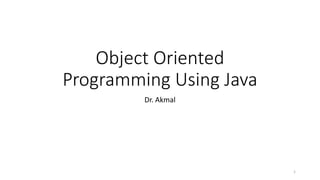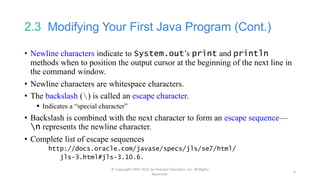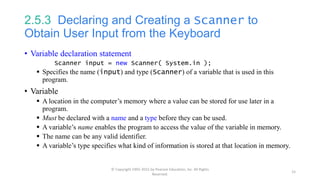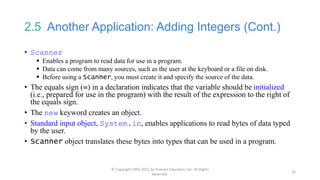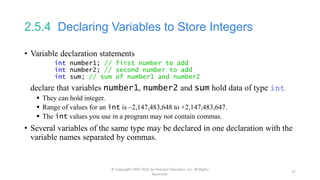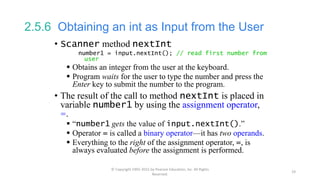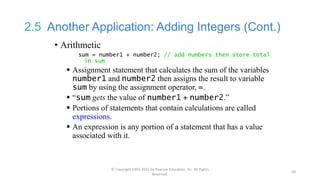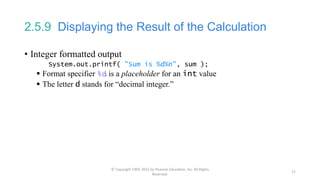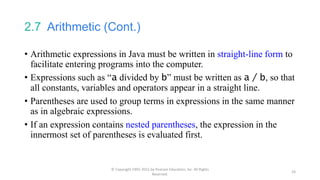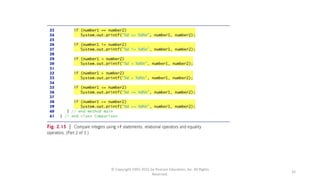OOP Using Java Ch2 all about oop .pptx
- 1. Object Oriented Programming Using Java Dr. Akmal 1
- 2. Chapter 2 Introduction to Java Applications; Input/Output and Operators Java™ How to Program, 10/e © Copyright 1992-2015 by Pearson Education, Inc. All Rights Reserved. 2
- 3. © Copyright 1992-2015 by Pearson Education, Inc. All Rights Reserved. 3
- 4. 2.3 Modifying Your First Java Program • Class Welcome2, shown in Fig. 2.3, uses two statements to produce the same output as that shown in Fig. 2.1. • New and key features in each code listing are highlighted. • System.out’s method print displays a string. • Unlike println, print does not position the output cursor at the beginning of the next line in the command window. The next character the program displays will appear immediately after the last character that print displays. © Copyright 1992-2015 by Pearson Education, Inc. All Rights Reserved. 4
- 5. © Copyright 1992-2015 by Pearson Education, Inc. All Rights Reserved. 5
- 6. 2.3 Modifying Your First Java Program (Cont.) • Newline characters indicate to System.out’s print and println methods when to position the output cursor at the beginning of the next line in the command window. • Newline characters are whitespace characters. • The backslash () is called an escape character. Indicates a “special character” • Backslash is combined with the next character to form an escape sequence— n represents the newline character. • Complete list of escape sequences http://docs.oracle.com/javase/specs/jls/se7/html/ jls-3.html#jls-3.10.6. © Copyright 1992-2015 by Pearson Education, Inc. All Rights Reserved. 6
- 7. © Copyright 1992-2015 by Pearson Education, Inc. All Rights Reserved. 7
- 8. © Copyright 1992-2015 by Pearson Education, Inc. All Rights Reserved. 8
- 9. 2.4 Displaying Text with printf • System.out.printf method f means “formatted” displays formatted data • Multiple method arguments are placed in a comma-separated list. • Calling a method is also referred to as invoking a method. • Java allows large statements to be split over many lines. Cannot split a statement in the middle of an identifier or string. • Method printf’s first argument is a format string May consist of fixed text and format specifiers. Fixed text is output as it would be by print or println. Each format specifier is a placeholder for a value and specifies the type of data to output. • Format specifiers begin with a percent sign (%) and are followed by a character that represents the data type. • Format specifier %s is a placeholder for a string. © Copyright 1992-2015 by Pearson Education, Inc. All Rights Reserved. 9
- 10. © Copyright 1992-2015 by Pearson Education, Inc. All Rights Reserved. 10
- 11. 2.5 Another Application: Adding Integers • Integers Whole numbers, like –22, 7, 0 and 1024) • Programs remember numbers and other data in the computer’s memory and access that data through program elements called variables. • The program of Fig. 2.7 demonstrates these concepts. © Copyright 1992-2015 by Pearson Education, Inc. All Rights Reserved. 11
- 12. © Copyright 1992-2015 by Pearson Education, Inc. All Rights Reserved. 12
- 13. © Copyright 1992-2015 by Pearson Education, Inc. All Rights Reserved. 13
- 14. 2.5.1 import Declarations • Helps the compiler locate a class that is used in this program. • Rich set of predefined classes that you can reuse rather than “reinventing the wheel.” • Classes are grouped into packages—named groups of related classes—and are collectively referred to as the Java class library, or the Java Application Programming Interface (Java API). • You use import declarations to identify the predefined classes used in a Java program. © Copyright 1992-2015 by Pearson Education, Inc. All Rights Reserved. 14
- 15. 2.5.3 Declaring and Creating a Scanner to Obtain User Input from the Keyboard • Variable declaration statement Scanner input = new Scanner( System.in ); Specifies the name (input) and type (Scanner) of a variable that is used in this program. • Variable A location in the computer’s memory where a value can be stored for use later in a program. Must be declared with a name and a type before they can be used. A variable’s name enables the program to access the value of the variable in memory. The name can be any valid identifier. A variable’s type specifies what kind of information is stored at that location in memory. © Copyright 1992-2015 by Pearson Education, Inc. All Rights Reserved. 15
- 16. 2.5 Another Application: Adding Integers (Cont.) • Scanner Enables a program to read data for use in a program. Data can come from many sources, such as the user at the keyboard or a file on disk. Before using a Scanner, you must create it and specify the source of the data. • The equals sign (=) in a declaration indicates that the variable should be initialized (i.e., prepared for use in the program) with the result of the expression to the right of the equals sign. • The new keyword creates an object. • Standard input object, System.in, enables applications to read bytes of data typed by the user. • Scanner object translates these bytes into types that can be used in a program. © Copyright 1992-2015 by Pearson Education, Inc. All Rights Reserved. 16
- 17. 2.5.4 Declaring Variables to Store Integers • Variable declaration statements int number1; // first number to add int number2; // second number to add int sum; // sum of number1 and number2 declare that variables number1, number2 and sum hold data of type int They can hold integer. Range of values for an int is –2,147,483,648 to +2,147,483,647. The int values you use in a program may not contain commas. • Several variables of the same type may be declared in one declaration with the variable names separated by commas. © Copyright 1992-2015 by Pearson Education, Inc. All Rights Reserved. 17
- 18. 2.5.5 Prompting the User for Input • Prompt Output statement that directs the user to take a specific action. • Class System Part of package java.lang. Class System is not imported with an import declaration at the beginning of the program. © Copyright 1992-2015 by Pearson Education, Inc. All Rights Reserved. 18
- 19. 2.5.6 Obtaining an int as Input from the User • Scanner method nextInt number1 = input.nextInt(); // read first number from user Obtains an integer from the user at the keyboard. Program waits for the user to type the number and press the Enter key to submit the number to the program. • The result of the call to method nextInt is placed in variable number1 by using the assignment operator, =. “number1 gets the value of input.nextInt().” Operator = is called a binary operator—it has two operands. Everything to the right of the assignment operator, =, is always evaluated before the assignment is performed. © Copyright 1992-2015 by Pearson Education, Inc. All Rights Reserved. 19
- 20. 2.5 Another Application: Adding Integers (Cont.) • Arithmetic sum = number1 + number2; // add numbers then store total in sum Assignment statement that calculates the sum of the variables number1 and number2 then assigns the result to variable sum by using the assignment operator, =. “sum gets the value of number1 + number2.” Portions of statements that contain calculations are called expressions. An expression is any portion of a statement that has a value associated with it. © Copyright 1992-2015 by Pearson Education, Inc. All Rights Reserved. 20
- 21. 2.5.9 Displaying the Result of the Calculation • Integer formatted output System.out.printf( "Sum is %d%n", sum ); Format specifier %d is a placeholder for an int value The letter d stands for “decimal integer.” © Copyright 1992-2015 by Pearson Education, Inc. All Rights Reserved. 21
- 22. 2.7 Arithmetic • Arithmetic operators are summarized in Fig. 2.11. • The asterisk (*) indicates multiplication • The percent sign (%) is the remainder operator • The arithmetic operators are binary operators because they each operate on two operands. • Integer division yields an integer quotient. Any fractional part in integer division is simply truncated (i.e., discarded)—no rounding occurs. • The remainder operator, %, yields the remainder after division. © Copyright 1992-2015 by Pearson Education, Inc. All Rights Reserved. 22
- 23. © Copyright 1992-2015 by Pearson Education, Inc. All Rights Reserved. 23
- 24. 2.7 Arithmetic (Cont.) • Arithmetic expressions in Java must be written in straight-line form to facilitate entering programs into the computer. • Expressions such as “a divided by b” must be written as a / b, so that all constants, variables and operators appear in a straight line. • Parentheses are used to group terms in expressions in the same manner as in algebraic expressions. • If an expression contains nested parentheses, the expression in the innermost set of parentheses is evaluated first. © Copyright 1992-2015 by Pearson Education, Inc. All Rights Reserved. 24
- 25. 2.7 Arithmetic (Cont.) • Rules of operator precedence Multiplication, division and remainder operations are applied first. If an expression contains several such operations, they are applied from left to right. Multiplication, division and remainder operators have the same level of precedence. Addition and subtraction operations are applied next. If an expression contains several such operations, the operators are applied from left to right. Addition and subtraction operators have the same level of precedence. • When we say that operators are applied from left to right, we are referring to their associativity. • Some operators associate from right to left. • Complete precedence chart is included in Appendix A. © Copyright 1992-2015 by Pearson Education, Inc. All Rights Reserved. 25
- 26. © Copyright 1992-2015 by Pearson Education, Inc. All Rights Reserved. 26
- 27. © Copyright 1992-2015 by Pearson Education, Inc. All Rights Reserved. 27
- 28. 2.7 Arithmetic (Cont.) • As in algebra, it’s acceptable to place redundant parentheses (unnecessary parentheses) in an ex-pression to make the expression clearer. © Copyright 1992-2015 by Pearson Education, Inc. All Rights Reserved. 28
- 29. 2.8 Decision Making: Equality and Relational Operators • Condition An expression that can be true or false. • if selection statement Allows a program to make a decision based on a condition’s value. • Equality operators (== and !=) • Relational operators (>, <, >= and <=) • Both equality operators have the same level of precedence, which is lower than that of the relational operators. • The equality operators associate from left to right. • The relational operators all have the same level of precedence and also associate from left to right. © Copyright 1992-2015 by Pearson Education, Inc. All Rights Reserved. 29
- 30. © Copyright 1992-2015 by Pearson Education, Inc. All Rights Reserved. 30
- 31. © Copyright 1992-2015 by Pearson Education, Inc. All Rights Reserved. 31
- 32. © Copyright 1992-2015 by Pearson Education, Inc. All Rights Reserved. 32
- 33. © Copyright 1992-2015 by Pearson Education, Inc. All Rights Reserved. 33
- 34. 2.8 Decision Making: Equality and Relational Operators (Cont.) • An if statement always begins with keyword if, followed by a condition in parentheses. Expects one statement in its body, but may contain multiple statements if they are enclosed in a set of braces ({}). The indentation of the body statement is not required, but it improves the program’s readability by emphasizing that statements are part of the body. • Note that there is no semicolon (;) at the end of the first line of each if statement. Such a semicolon would result in a logic error at execution time. Treated as the empty statement—semicolon by itself. © Copyright 1992-2015 by Pearson Education, Inc. All Rights Reserved. 34
- 35. © Copyright 1992-2015 by Pearson Education, Inc. All Rights Reserved. 35
